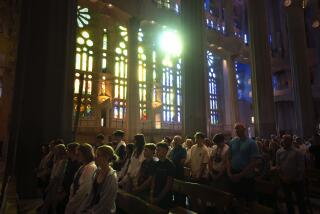Atheist China’s Tourism Bureau Finds Religion
LHASA, China — The Jokhang Temple, one of Tibetan Buddhism’s most sacred sites, has endured theological feuds, political upheaval and widespread destruction at the hands of ax-wielding communist Red Guards.
But nothing in the temple’s rough history prepared its monks for what may be the biggest threat yet to their monastic existence -- tourists.
Already under tight supervision by communist authorities, the monks now find themselves playing tour guide, doorman and janitor to thousands of daily visitors attracted by the Chinese government’s drive to exploit Tibet’s rich and still active religious heritage.
“This used to be my college, but now it’s like a museum,” said Nyima Tsering, a vice chairman of the temple’s government-appointed management committee and a Buddhist scholar at its seminary. “I’d prefer if they wouldn’t come.”
After decades of suppressing and then tightly regulating Tibetan Buddhism, China’s government is heavily promoting the faith and its monuments as tourism lures to boost the Himalayan region’s lagging economy.
Yet China remains a communist state that is officially atheist. As the Tourism Bureau invites outsiders to “Come visit the holy land,” officials continue to limit the number of monks per monastery, dictate how they run temples, and bar children from participating in Buddhist festivals or other forms of religious expression.
Many of Tibet’s 46,000 Buddhist monks and nuns find the influx of tourists another burden. Between visitor duties and mandatory Communist Party political study sessions, Nyima Tsering estimates that he has just two hours a day for religious learning, a pursuit to which monks once devoted most of their time.
The lack of study shows in the quality of newly graduating lamas, he says, contending that they lack the depth of understanding their predecessors gained during decades of contemplation of Buddhist sutras, or holy texts.
Authorities say they aim for a balance between religious life and tourism in Tibet, which has 2.6 million people. But they are pressing ahead with plans to renovate more temples and bring in more visitors.
The flow of visitors has surged by double-digit rates the last three years, driven largely by huge increases in the number of travelers from other parts of China. Last year, the Tourism Bureau says, 856,000 tourists came to Tibet, only about 140,000 of them from overseas.
Authorities were hoping to top 1 million this year. But the SARS outbreak in China, although it bypassed Tibet, shut the industry for months.
The government is planning for tourism’s share of the regional economy to rise from 6% to 10% by the end of the decade, said Gyallo, deputy director general of the Tourism Bureau, who like many Tibetans uses just one name.
Although most visitors now avoid the bone-jarring roads and fly into Lhasa, tourism is expected to see a new surge after a railway linking Lhasa to the rest of China opens in 2005.
Gyallo says tourists come not just for monuments but for clean air and wild mountains. But it is Tibet’s Buddhist heritage and otherworldly atmosphere that defines it for many travelers.
During the annual yogurt festival in August, thousands of Chinese tourists streamed up the rugged hillside behind the Drepung Lamasery on Lhasa’s western outskirts. Mixing with kneeling Tibetan celebrants, they gazed at a huge silk embroidered tapestry of Sakyamuni, the founder of Buddhism, that was unfurled across the cliff face.
On the rough mountain road leading to Lhasa, Chinese women tourists in fur coats and gold-rimmed sunglasses recently stood facing the holy mountain of Nojin Gangsang, their eyes closed, arms raised and palms facing out as if to absorb its spiritual energy.
“It’s really moving. I’m so glad I got up early to see it,” said Chen Yuming, a college student from the eastern city of Nanjing. “The mountains are here, but it’s Buddhist culture that makes Tibet special.”
Although the temples get some benefit from tourism revenues, monks have little or no say in how open they want to be to visitors.
Communist control over temples and monasteries has tightened in an intensive drive to eliminate support for the Dalai Lama, Tibet’s traditional spiritual and temporal leader who fled to India in 1959 after a failed uprising against Chinese rule.
At Jokhang, monks elected their own representatives on the management committee until 1996, when authorities began appointing members. In addition to seven monks, the committee also includes two government officials who transmit orders and supervise compliance, monks say.
The government contends that tourism has invigorated Buddhism, citing money spent on restoring more than 1,700 religious sites. Unstressed is the fact that many of the sites were badly damaged by the Communist Party’s Red Guards during the 1967-77 Cultural Revolution.
“We’ll never allow temples to become purely museums. At heart, they will remain places of religious activity,” said Liu Shizhong, a department chief with the Lhasa Bureau of Cultural Relics.
Others aren’t so sure.
“Money from tourists pays for restoration,” said another monk at Jokhang, who refused to give his name for fear of government retribution. “But that’s just for the tourists to see, and more will come.”
More to Read
Sign up for Essential California
The most important California stories and recommendations in your inbox every morning.
You may occasionally receive promotional content from the Los Angeles Times.










